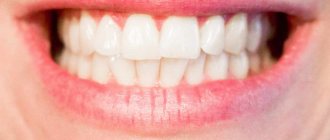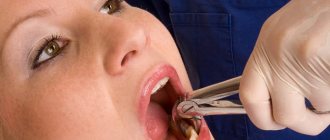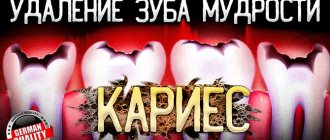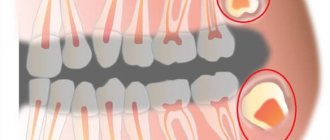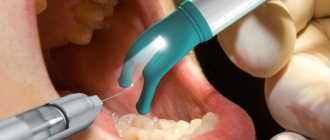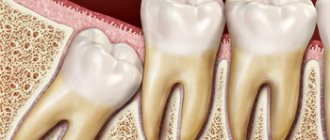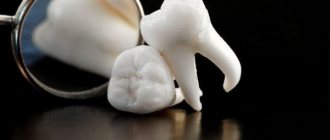Osteosynthesis is a surgical treatment for a jaw fracture , which involves the use of special, most often metal, plates to fix the fragments. The operation is performed in cases where connecting bone elements with a splint is difficult or impossible, or it is difficult to fix them in the correct position. In modern practice, several methods of jaw osteosynthesis using plates are used. The choice of a specific technique depends on the severity of the injury and its nature.
Plates for jaw fracture
The use of plates after a jaw fracture is justified when a conservative treatment method either does not give the desired result (correct reposition and high-quality fusion of bone parts) or cannot be used initially (complex injury). The decision to perform an operation is made by the doctor after examining the patient (examination if treatment methods other than surgery have already been used).
The advantage of bone osteosynthesis is that when plates are installed to connect fragments, the lesion site is well supplied with blood. This ensures fairly rapid fusion - in just a few weeks - while restoring the bone itself (integrity) and its anatomically correct structure.
Types of jaw osteosynthesis
Osteosynthesis with a metal plate for a jaw fracture is carried out in different ways. It is divided into types according to 2 characteristics - the method of fixing the plates and the technology of the operation itself.
- According to the method of fixing the plate for a jaw fracture, osteosynthesis can be: focal, when the elements of the plate are installed so as to cross the fracture gap and adjoin it;
- extrafocal, in which the plate is fixed outside the jaw fracture gap or passes through it above the mucous membrane and skin (without touching damaged tissues).
- open is carried out with dissection of soft tissues and “opening” of the ends of bone fragments (separation of the periosteum);
The closed method provides accelerated healing, since it does not involve complications that are possible due to impaired microcirculation in soft tissues. But the lack of visual control during closed osteosynthesis of the jaw makes it difficult to properly connect the bone elements and carry out the manipulation in general. This requires a very highly qualified specialist.
The open method of installing plates for jaw fractures (with visualization of the bone) makes it possible to most accurately compare the fragments, as well as remove damaged (interposed) soft tissues or small fragments of hard tissue. The main difficulty of the operation is the risk of tissue hypoxia, which is a common cause of enchondral osteogenesis.
The latter involves the transition of callus to the stage of cartilage, which is not typical for the lower jaw. With enchondral osteogenesis, the formation of a typical (ossified) callus of the lower jaw slows down.
Modern methods also include ultrasonic osteosynthesis with plates . It is carried out using special modern technology and is less traumatic. Installing plates for fractures using ultrasound equipment reduces the likelihood of complications.
Why does the lower jaw break?
Experts note that in the vast majority of clinical cases, pathology occurs due to injuries received in everyday life. These are falls, blows. You can get injured by slipping, doing physical activity and traumatic sports, or in active games (for children). The number of fights, domestic conflicts under the influence of alcohol and drugs, and road traffic accidents, due to which people suffer a broken jaw, as in the photo, are growing. Some people encounter problems with poor industrial safety on the shop floor, when working with heavy equipment and at heights.
This is what a mandibular fracture looks like
For many, it comes as a surprise that a fracture of the lower jaw can be caused by a number of dental and chronic diseases. As a rule, such trauma is caused by advanced pathologies, for example, a follicular cyst that has grown on the root of a tooth, or osteomyelitis. Oncological tumors, metabolic disorders and osteoporosis can also gradually destroy bone tissue, as a result of which the patient develops symptoms of a fracture.
According to statistics, young men (under 40 years of age) receive such injuries more often than women. The male sex tends to engage in dangerous sports, works in heavy industries, more often takes part in fights, and has a tendency to take risks and aggression.
Some researchers also argue that in rare cases, damage can occur during dental procedures, for example, during tooth extraction in case of extremely low qualifications of the doctor.
Indications for osteosynthesis of the jaw with plates
The main indication for installing metal plates for osteosynthesis is the prevention of complications that cannot be effectively prevented by applying a traditional splint. In the case of osteosynthesis, an important task for the surgeon is to compare the fragments and fix them in the correct position. If successful, fusion will take up to 3–4 weeks.
Indications:
- fracture behind a row of teeth;
- inflammation that provoked injury;
- significant displacement of bone elements;
- high mobility of teeth at the fracture site;
- incorrect position of the jaws relative to each other.
Removal of the pin-rod apparatus, Ilizarov apparatus after surgery
Removing the Ilizarov apparatus is not difficult, since the needles and rods are located above the skin. After general or regional anesthesia is performed, the wires are “bitten” and removed from the bone. If there are rods, they unscrew. Wounds are treated with antiseptic solutions and aseptic dressings are applied.
Our clinic performs removal of all types of metal structures.
The cost of removing a metal structure depends on the complexity of the operation and the location of the implant, as well as on the type of anesthesia that is required for removal.
| Type of operation | Cost, rub.) |
| Removing the plate | from 28 000 |
| Removal of metal structures from the patella | from 28 000 |
| Removing a pin from tubular bones (rod) | from 28 000 |
| Removing dynamic, positioning screw | from 9 000 |
| Removing the spokes (end above the skin) | from 2 000 |
| Removing the spokes (end under the skin) | from 4 000 |
| Dismantling the Ilizarov apparatus | from 14 000 |
| Type of anesthesia | |
| Local anesthesia | 700 |
| Conduction anesthesia | from 3 000 |
| Spinal anesthesia | from 9 000 |
| Intravenous anesthesia | from 4 500 |
| Osteosynthesis | To the list of articles | Hospitalization of patients to the clinic |
Installation
Installation of plates for a jaw fracture using the open method is carried out in 4 stages:
- a soft tissue incision is made to visualize and connect the fragments;
- connecting bone fragments using a plate;
- fixation of bone elements with glue, staples, quick-hardening plastics used in modern surgery;
- suturing.
The main difficulty of open surgery is trauma. The doctor works with the area in which the nerve endings and salivary glands are located, which creates the risk of damage to them, and therefore determines high requirements for the qualifications of the specialist.
A safer and less traumatic method is ultrasonic osteosynthesis of the jaw. It not only reduces the risk of complications during fixation, but also reduces the time for fracture healing.
How can you tell if a person has a broken jaw?
A person who has suffered such a serious injury experiences severe pain that radiates throughout the head. Due to the painful shock, you can lose consciousness or experience severe dizziness. Nausea and vomiting are possible. It becomes impossible to open or, conversely, close your mouth; accordingly, in this state you cannot chew, swallow, speak, and sometimes even breathe. Saliva and blood may involuntarily flow from the mouth.
It is visually noticeable that the lower jaw has shifted relative to the upper jaw, and facial asymmetry has appeared. The lower row of teeth has also shifted relative to the upper one. With open fractures of the jaw, some teeth are often twisted, knocked out, broken, they can stagger, tilt and fall out.
With such an injury, the dentition shifts
A little later, a person with a similar injury may feel numbness in the chin area, which indicates that the trigeminal nerve has been damaged in the process. Another striking symptom indicating a problem is bleeding not only from the mouth, but also from the nose and ears. Naturally, in a person with a similar problem it is difficult not to notice bruises, hematomas, bruises, and wounds of different nature.
A jaw fracture is often accompanied by other injuries, damage to the head and body, and concussion.
Recovery after surgery
Rehabilitation after installation of a titanium plate for a jaw fracture takes 6 months. The specific recovery time depends on how much time has passed from the moment of injury to treatment, as well as on the patient’s age, his condition, the severity of the injury, and the method of osteosynthesis.
Rules during rehabilitation:
- immediately after the manipulation, a bandage is applied for fixation; it must be worn constantly;
- it is important to exclude any movements (talking, chewing, opening and closing the mouth);
- drug rehabilitation involves taking a course of antibiotics and restoratives, the drugs are selected individually and prescribed by a doctor;
- for recovery, the patient is prescribed decongestant and anti-inflammatory physiotherapy (from day 2 - UHF, from day 4 - magnetic therapy, after 2 weeks you can start a course of electrophoresis);
- classes in LVF (therapeutic and restorative physical education) begin 3–5 weeks after removing the fixing bandage, their goal is to restore normal speech function, normalize chewing, and facial expressions.
For the entire recovery period after installation of a plate for a fracture, the patient is prescribed a diet (liquid meals, purees, strictly at room temperature, taken through a straw). Solid food is introduced into the diet gradually after the bandage is removed and chewing functions are restored.
To avoid complications, it is important to maintain good oral hygiene. You can brush your teeth only after removing the bandage and restoring mobility, so in the first weeks hygiene comes down to rinsing your mouth, which should be done up to 10 times a day (including after each meal).
Instructions for wearing a diagnostic and treatment splint - SPLINT
Dear patient! We are very glad to see you among our patients. Our team will do everything necessary to make your path to the health of the dental system and temporomandibular joint as fast and comfortable as possible. Please read the basic recommendations for wearing a splint (mouthguard) and caring for your mouth during treatment.
Splint therapy is carried out using a special mouthguard (Michigan splint, occlusal splint), made for the upper or lower jaw individually for each patient. The mouthguard is made of hard plastic and is not subject to deformation when compressed.
The objectives of Splint therapy can be:
● Differential diagnosis of pain dysfunction of the mandibular joint.
● Relaxation of the muscular system.
● Search for the true position of the lower jaw.
● Prevention and/or stabilization of increased tooth wear.
● Prevention of wedge-shaped defects due to overload of teeth.
At the stage of splint therapy, the patient must be under dynamic observation and visit the attending physician approximately once every two weeks. This mode provides the doctor with the opportunity to assess the dynamics of the patient’s condition and timely correct the mouth guard. It is recommended to wear the splint for as many hours as possible.
Must be worn at night and during all free time during the day. The ideal option is 24/7 use. You can eat food in the mouth guard, but chewing may take longer than usual. If it is impossible to eat in the mouthguard, it can be removed. In the first 2-3 days of wearing, the body gets used to the mouth guard. At this time, there may be increased salivation, changes in diction, slight discomfort in the oral cavity (pressure on the teeth, irritation of the cheeks, lips, gums). When used correctly, unpleasant sensations disappear in the first days of adaptation. While wearing a mouth guard, you may experience discomfort in the joint and muscles: stretching, tension, etc. These symptoms are considered normal.
Sharp pain is not acceptable! In such cases, it is necessary to remove the aligner and not put it on until your next visit to your doctor.
IMPORTANT: it is unacceptable to replace existing fillings or crowns while wearing a mouth guard. This will make it impossible to seat the splint, which will require its re-production.
Splint care: It is necessary to maintain proper hygiene of both teeth and mouthguard using a toothbrush and toothpaste. Store in a special plastic container (bix) issued by your doctor. Avoid the possibility of damage to the mouth guard by pets. If the mouth guard becomes dirty, rinse it in warm water.


